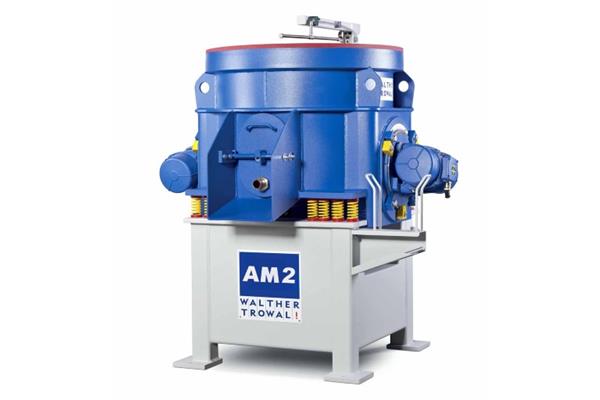
Walther Trowal designed the "AM post process machines" model range AM for refining the surface of components produced with additive manufacturing.
To remove the markings of removed support structures and sintered-on powder residue which can be found on 3D printed components after their surface has been polished, Walther Trowal has developed the "AM post process machines" model range AM, which can create surface finishes in one single step.
In fact, most 3D printed components are produced by placing material layers on top of each other, creating a "staircasing" effect on their surface with, generally, a very high initial surface roughness. For this reason, many of these components must undergo a surface smoothing or polishing operation before the components can be further processed or utilized.
Mass finishing has proven to be the ideal surface finishing method for 3D printed components: these are completely embedded in the moving grinding media so that the process is very gentle and produces homogeneous and repeatable surface finishes. Moreover, the media also reaches internal passages and undercuts in the components.
The AM post process
Depending on the size of the processing bowl, up to 100 small work pieces or single components with a size of 900 x 500 mm can be treated in the model range AM of the
new "multivib" vibrators. The work pieces are mounted on a carrier plate, which in turn is clamped to the bottom of the processing bowl by mechanical or electromagnetic means. Once the work pieces are in place, the media is filled into the processing bowl. During the process compound and water are continuously added. Three vibratory motors induce an intensive vibration into the processing bowl. Since the vibratory movement generated by the motors is overlapping, the component surface becomes smoother, while the edges are left intact. After a pre-determined cycle time the process is completed, and the finished work pieces can be removed.
Several manufacturers of automotive, aircraft and medical components are already using the new AM "multivib" vibrators. These machines reduce the surface roughness of the raw work pieces from around Ra = 2 to 80 µm down to a value of 0.025 µm.
"Additive manufacturing and mass finishing are an ideal combination because most 3D printed components must have an excellent surface finish to fulfill their function. For example, turbine blades require an airflow with minimal friction loss. Components with stringent specifications for hardness and strength benefit from the homogeneous peening effect induced by mass finishing. This finishing method is especially advantageous for 3D printed components with bionic shapes", said Maximilian Beien, Sales Manager at Walther Trowal.
Mass finishing is suitable for a wide range of materials utilized in additive manufacturing, i.e. for high performance, difficult-to-machine metals like titanium, nickel based or cobalt-chrome alloys, but also for non-ferrous metals or plastic. Walther Trowal grinding media and other consumables are already approved for many materials and safety-relevant components and processes.
"Compared to electro-chemical finishing methods mass finishing achieves the desired surface smoothness and luster in one single operation. Another advantage is that the mass finishing equipment is very compact with a small footprint. The result: An excellent surface finish, surprisingly short cycle times and an overall high cost-efficiency, not only with regard to the capital expenditures but also the operating costs", adds Beien.